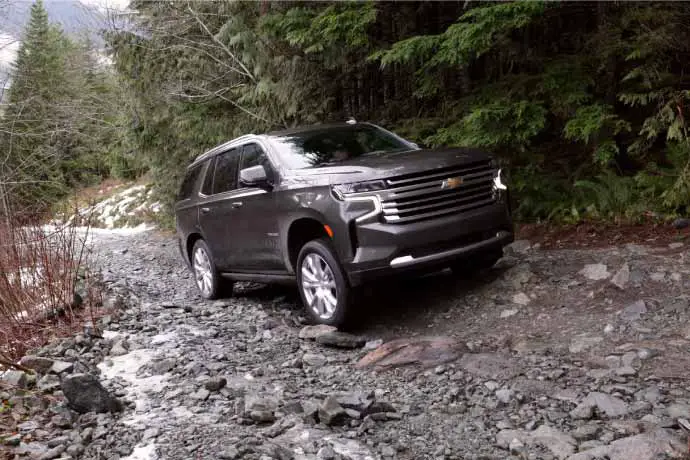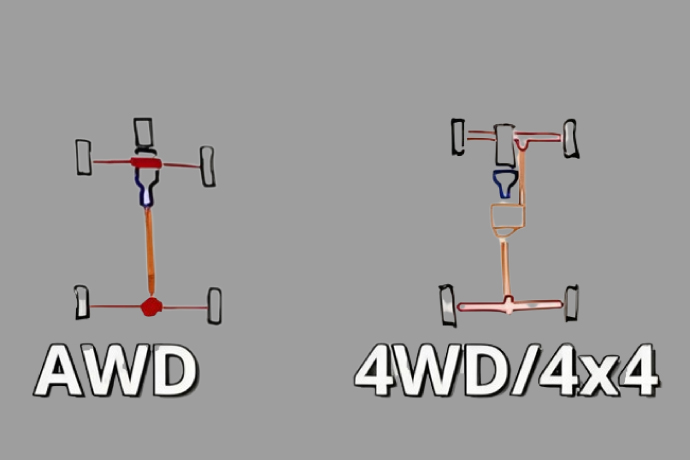Four-wheel drive (4WD) is a vehicle drivetrain system that allows all four wheels to receive power from the engine.
This is beneficial in slippery or off-road conditions, as it provides increased traction and control. However, many people wonder if it is safe to drive 70 mph in 4WD.
The answer to this question depends on several factors, including the type of 4WD system in your vehicle, the road conditions, and the speed limit.
Generally, it is not recommended to drive in 4WD on dry pavement at high speeds. This is because it can cause some problems.
But driving in 4WD at 70 mph on snow- or ice-covered roads is safe. It helps you maintain traction and control.
In this article, I have explained the different types of 4-wheel drive systems, how to use them safely, and when it is appropriate to drive in 4WD at 70 mph.
I have also provided tips for troubleshooting common problems with 4WD systems and how to maintain them.
What is 4 Wheel Drive?

4-wheel drive is a vehicle propulsion system that delivers power to all four wheels simultaneously.
This system provides enhanced traction and control, particularly in challenging terrain and adverse weather conditions.
The 4WD system works through a transfer case, which spits the engine’s power between the front and rear axles.
A typical 4WD system consists of the following components:
- Engine
- Transmission
- Transfer case
- Front and rear axles
- Driveshafts
- Wheels
Can You Drive 70 MPH in 4 Wheel Drive?
Yes, you can drive 70 mph in 4-wheel drive, but it is not recommended to do so at all times. This is because it can cause some potential problems, too. Therefore, before doing so, it is important to consider a few things:
First, it is necessary to note that not all 4WD systems are designed for high-speed driving. Some 4WD systems, such as part-time 4WD systems, are designed for use in slippery or off-road conditions only. Driving a part-time 4WD system at high speeds on dry pavement can damage the system and reduce its lifespan.
Second, even if your 4WD system is designed for high-speed driving, you must be aware of the increased wear and tear on your vehicle’s drivetrain. Driving in 4WD can reduce fuel economy and increase wear and tear on your tires, brakes, and other components.
Finally, you must be aware of the different handling characteristics of your vehicle in 4WD. In general, vehicles in 4WD are more challenging to steer and have a higher tendency to oversteer. This is because the front and rear axles are constantly trying to rotate at different speeds.
Risks of Driving in 4WD at High Speed
- Increase wear and tear on the drivetrain.
- Reduced fuel economy.
- Fuel pump failure
- Increased risk of oversteer and understeer.
- More difficult to steer.
If you do need to drive in 4WD at 70 mph, be sure to take the following precautions:
- Drive carefully and be aware of your surroundings.
- Be prepared for reduced fuel economy.
- Avoid sudden acceleration and braking.
Tips for Driving Safely in 4WD at 70 MPH
- Make sure that the tires are properly inflated and in good condition.
- Ensure that your vehicle’s 4WD system is designed for high-speed driving.
- Be aware of the different handling characteristics of your vehicle in 4WD.
- Be aware of the road conditions and choose a safe speed.
- Be prepared for the oversteer and understeer.
- Be especially careful when driving on slippery or winding roads.
- Disengage the 4WD as soon as you have exited the slippery or off-road conditions.
Tricks for Improving Fuel Economy and Reducing Wear and Tear When Driving in 4WD at 70 MPH
- Use the cruise control if available.
- Maintain a steady speed.
- Avoid accelerating and braking unnecessarily.
- Keep your tires properly inflated.
- Have your vehicle’s drivetrain serviced regularly.
Technically, it is possible to drive 70 mph in 4WD safely, but it is necessary to be aware of the potential risks and appropriate precautions.
When to Use 4 Wheel Drive
You can use 4-wheel drive in the following conditions:
1. Off-road driving: 4WD provides increased traction and control in off-road conditions, such as sand, mud, and rocks.
2. Slipper road conditions (snow, ice, rain, mud): 4WD can help you maintain traction and control on slippery roads, reducing the risk of skidding and losing control of your vehicle.
3. Towing heavy loads: 4WD helps tow heavy loads by distributing the weight more evenly and providing increased traction.
4. Starting on a hill in slippery conditions: When faced with a steep incline on a slippery surface, 4WD helps by preventing the vehicle from rolling backward and improving the vehicle’s ability to ascend the hill safely.
Characteristics of 4WD System
- Increased Traction and Control: By sending power to all four wheels, 4WD helps vehicles maintain traction and control in slippery or off-road conditions.
- Improved Acceleration and Hill-Climbing Ability: 4WD systems also improve acceleration and hill-climbing ability.
- Transfer Case: At the heart of a 4WD system is the transfer case, a crucial component that divides power between the front and rear axles. Drivers can often select between 2WD and 4WD modes, depending on the driving conditions.
- Safety: 4WD improves safety in adverse weather conditions, helping drivers maintain better control during rain, snow, or icy road conditions. This makes it an attractive option for some people who live in regions with extreme weather.
- Reduce Wear and Tear: When towing heavy loads, 4WD helps to reduce wear and tear on the drivetrain. This is because the power is being distributed across all four wheels rather than just two wheels.
In addition to the characteristics listed above, 4WD systems also have some other features, such as:
- Locking Differentials: Locking differentials prevents the wheels on an axle from spinning independently of each other. It is helpful in off-road conditions because, in this condition, it is important for all four wheels to be moving at the same speed.
- Low-range Transmission: A low-range transmission provides a gear ratio that is lower than the lowest gear in the regular transmission. It is useful in off-roading to have low-speed control.
- Hill Descent Control: Hill descent control is a system that helps vehicles maintain a safe speed when descending hills.
Types of 4 Wheel Drive

Typically, there are four main types of 4-wheel drive systems, including full-time 4WD, part-time 4WD, automatic 4WD, and all-wheel drive.
1. Full-Time 4WD
These systems are always engaged, meaning power is always sent to all four wheels.
This type of system is ideal for driving in slippery or off-road conditions, as it provides the most traction and control.
However, full-time 4WD systems can reduce fuel economy and increase wear and tear on the drivetrain.
2. Part-Time 4WD
The driver manually engages these systems, typically when driving in slick or off-road conditions.
Part-time 4WD systems are more fuel-efficient than full-time 4WD systems and cause less wear and tear on the drivetrain.
But they are not as effective as full-time 4WD in slippery or off-road conditions.
3. Automatic 4WD
These systems automatically engage and disengage the 4WD system based on the road conditions and vehicle speed.
This type of system is the most convenient, but it can also be the most expensive.
It is ideal for drivers who want a vehicle that can handle a variety of road conditions without manually engaging or disengaging 4WD.
4. All-Wheel Drive (AWD)
They are similar to full-time 4WD systems, but they use a different transfer case that allows the system to disengage when not needed.
This improves fuel economy and reduces wear and tear on the drivetrain.
AWD systems are ideal for driving in different conditions, including slippery roads and light off-roading.
Which Type of 4WD System is Right for You
The best type of 4WD system depends on your individual needs and driving habits.
Here are some quick tips to help you choose the right type of 4WD system for you:
- If you live in an area with heavy snow or ice, or if you do a lot of off-road driving, then a full-time 4WD system is the best option for you.
- If you are from an area with occasional snow or ice, or if you only do light off-road driving, then a part-time 4WD system is a good option.
- If you want a vehicle that can handle several road conditions without having to engage or disengage the 4WD system manually, then an AWD or Automatic 4WD system is the best option for you.
No matter which type of 4WD system you choose, it is important to remember that 4WD is not a substitute for safe driving.
Always drive carefully and be aware of your surroundings.
Dynamics of 4 Wheel Drive at High Speed
The dynamics of 4-wheel drive (4WD) at high speed are complex and vary depending on the specific vehicle and 4WD system.
However, there are some general principles and challenges associated with 4WD driving:
At high speed, the 4WD system must be able to distribute power to all four wheels effectively.
This is because the wheels will be rotating at different speeds, and the system must be able to compensate for this.
If the system cannot distribute power effectively, it can lead to wheel slip and loss of control.
One of the challenges of 4WD at high speed is that the front and rear axles have different traction levels.
This is due to a few factors, such as the type of tires, the road surface, and the weight distribution of the vehicle.
If the front axle has more traction than the rear axle, the system is typically prone to oversteering.
Oversteer is a condition where the vehicle’s rear slides out from under the driver’s control.
Another challenge of 4WD at high speed is that the system becomes more difficult to steer.
This is because the system constantly tries to distribute power to all four wheels.
This makes it difficult for the driver to make precise steering inputs.
Despite these challenges, 4WD vehicles can be safely driven at high speeds if the driver is aware of the system’s dynamics and takes appropriate precautions.
What to Do If Your Vehicle Get Stuck in 4 Wheel Drive
If your vehicle gets stuck in 4WD, follow these steps:
- Try to shift back to 2WD while the vehicle is moving slowly. This can work if the 4WD system is simply engaged but not yet fully locked in.
- If you can’t shift to 2WD while moving, try shifting to a lower gear and rocking the vehicle back and forth. This helps to dislodge the 4WD system from its locked position.
- If you still can’t shift to 2WD, you need to disengage the 4WD system manually. This process depends on the make and model of the vehicle, so consult your owner’s manual for specific instructions.
- Once you have disengaged the 4WD system, you should be able to shift back to 2WD and continue driving.
4WD Maintenance Tips

The 4WD vehicles require more maintenance than two-wheel drive (2WD) vehicles due to the additional components, such as transfer cases and differentials.
Follow these maintenance tips to keep your 4WD vehicle in good condition and extend its lifespan:
- Change the oil and filter in the transfer case and differential regularly. Consult your owner’s manual for proper instructions.
- Inspect the 4WD system for leaks and damage regularly. This includes checking the fluid levels in the transfer case and differential, as well as inspecting the driveshafts, U-joints, and other components.
- Grease the U-joints and other moving components of the 4WD system regularly. This can reduce wear and tear and extend the life of the components.
- Check the tire pressure regularly. Keep the tire pressure according to the manufacturer’s recommendations.
- Ensure a periodic inspection and service of the 4WD system by a professional mechanic.
How Fast Can You Drive in 4L?
4L is a low-speed four-wheel drive mode that is designed for maximum torque and traction.
It is typically used in challenging off-road conditions, such as steep hills, rocky terrain, and deep mud.
The recommended speed for driving in 4L is typically 10 mph (16.093 km/h), although some manufacturers also recommend driving at speeds below 15 mph (24.14 km/h).
Driving at high speeds in a 4L can damage the drivetrain and reduce its lifespan.
How Fast Can You Drive in 4H?
4H is a high-speed four-wheel drive mode designed to improve traction and control on slippery or uneven surfaces.
It is typically used in snow, ice, mud, and sand conditions.
4H is also used for towing and hauling heavy loads.
The recommended speed for driving in 4H is typically 55 mph (88.514 km/h).
However, it is important to note that the specific speed limits for driving in 4H depend on the vehicle and driving conditions.
Final Thoughts
While it is possible to drive 70 mph in 4WD, it is important to do so with caution.
4WD vehicles are more difficult to control at high speeds, especially in slippery or windy conditions.
Drivers should be mindful of this and drive accordingly.
Additionally, 4WD vehicles consume more fuel, and some vehicles with 4WD are less stable at high speeds.
Therefore, it is best to only use 4WD when needed and to disengage it when returning to dry pavement.

